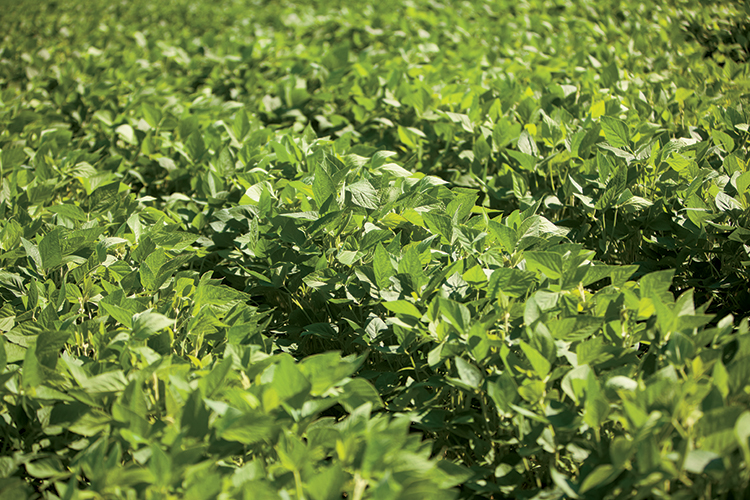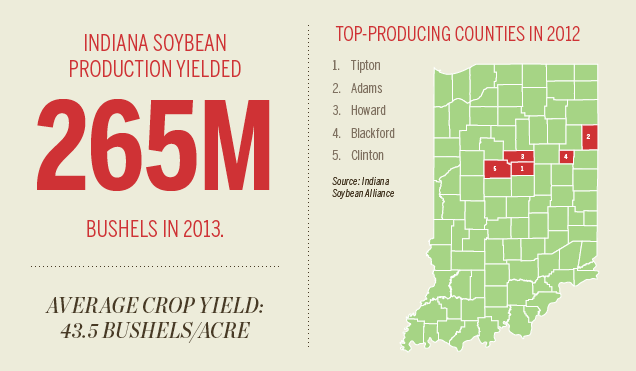Home > Indiana > Indiana Crops & Livestock > Soybeans Offer Fields of Promise
Soybeans Offer Fields of Promise
In partnership with: Indiana State Department of Agriculture

To get an idea of the volume of soybeans he has, all Josh Kirkpatrick has to do is look out on the acres and acres he and his brothers grow on their massive farm in Fountain County.
For an understanding of the crop’s diversity, he can look just about anywhere.
“Soybeans are in absolutely everything, it seems like,” says Kirkpatrick, who owns and operates Triple J Farms in Veedersburg with his brothers, James and John. “Time and time again, there are just more uses for soybean products. You’ve got biodiesel, soaps, candles, lotions, waxes. You look in your kitchen, and just about everything contains soy or soy products of some sort. The more products that are out there that can be made from soybeans, the more demand there’s going to be for what I’m growing. I just think it’s a beautiful thing.”
Moving Forward for Years
Soybeans are a beautiful thing for all of Indiana, which ranks third in the country in soybean processing and fourth in soybean production. Of the 238 million bushels produced in 2011, 208 million bushels were crushed into oil and meal for livestock feed, biodiesel, industrial uses and human consumption, according to the Indiana Soybean Alliance (ISA).
“Soybeans bring a significant economic impact to the state,” says Megan Kuhn, communications director for the ISA.
That impact will continue to grow as new advancements for soybeans emerge. Working with product development companies, entrepreneurs and universities, the ISA is continuously seeking new uses for soybeans, as well as helping the state’s farmers by promoting and marketing soy-based products.
“Soybean farmers have really been committed to looking for new uses for soybeans for the last 20 years,” Kuhn says.
She specifically points to a program that was developed in 1994 known as the Student Soybean Innovation Competition, through which students from Purdue University compete to develop innovative new products made from soybeans. The competition runs from September through March, and involves students from a broad range of backgrounds and academic studies.
“It’s all over the board,” Kuhn says of the variety of students who participate. “We’ve had them from chemistry, biology, marketing, engineering, agriculture, even nuclear engineering. It’s a good cross-section of students we’re reaching. We look at it two-fold. We’re looking for that next big product, but we’re also just as committed to introducing soybeans to the next generation of researchers and marketers,” she says.
Past winning teams have developed products such as soy excipient, denture cream and crayons.

High on High Oleic
One of the more promising developments for soybeans is the high oleic variety, which produces oil that functions better for human consumption, as well as for industrial uses such as biodiesel. Indiana was the second state, after Ohio, to have farmers growing high oleic soybeans, and production has increased tremendously.
“We’ve really seen those acres grow the last couple of years,” Kuhn says. “We see a lot of potential.”
Kirkpatrick, an ISA director representing Veedersburg in District III, planted 400 acres of high oleic soybeans and saw what he calls a “fantastic” yield in 2014. He is considering doubling his acreage of the variety.
“At the end of the day, the high oleic soybean is much healthier,” Kirkpatrick says. “It’s comparable to canola or palm oil for human consumption. But it has industrial uses as well.”
Kirkpatrick and his brothers are continuing the farming business started by their great-grandfather and passed down through their grandfather and father, now deceased. No doubt their ancestors would be pleased with the direction soybean production is going.
“There are a ton of uses,” Kirkpatrick says, “and I think we’re just now scratching the surface.”



